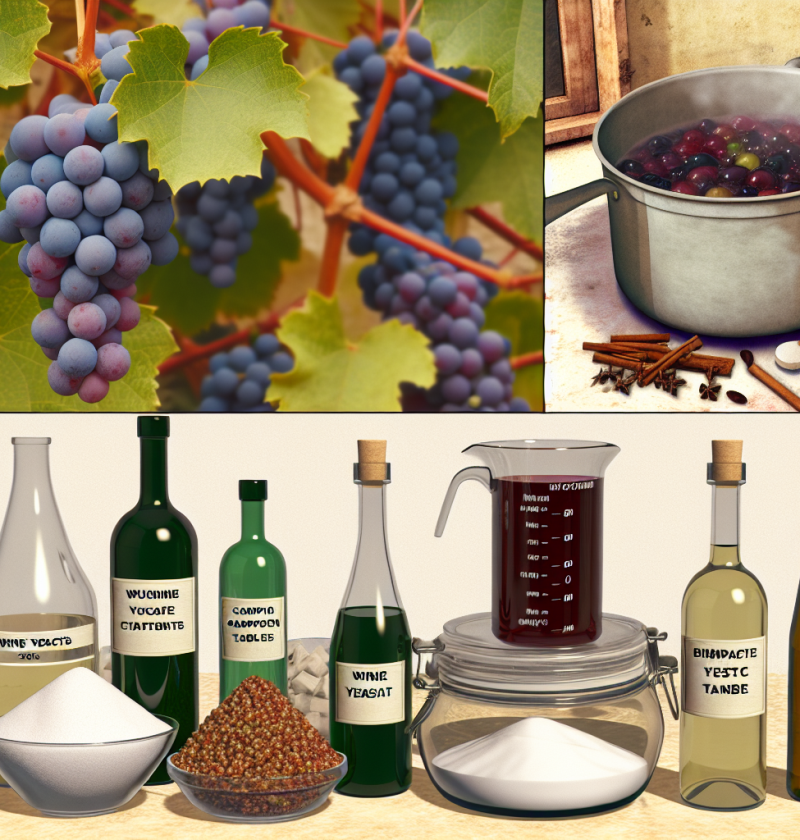“`html
The Ultimate Muscadine Wine Recipe: A Journey in Every Sip
There’s a magic in making your own wine that captives the soul. Imagine the clusters of ripe muscadines, basking in the sunlight, each grape holding the promise of a delightful, home-made wine that will elevate any meal. From its first sip that dances on your tongue to its lingering, bespoke flavors, muscadine wine offers a gratifying journey for your palate. Join me on this winery adventure and savor every moment as we craft this exquisite brew together.
Preparation Time
- Initial Preparation: 1 hour
- Primary Fermentation: 1-2 weeks
- Secondary Fermentation: 1 month
- Maturation: 6-12 months
This recipe yields approximately 6 bottles of wine and is of medium difficulty.
The Necessary Ingredients (Possible in All Kinds of Variations)
Before we delve into the step-by-step process, let’s gather our ingredients. If you’re looking to switch things up for a vegan or gluten-free version, those adjustments can be seamlessly made.
– 15 pounds of fresh muscadine grapes
– 3 pounds of sugar (substitute with agave syrup for a vegan option)
– 1 gallon of water
– 1 packet of wine yeast (for gluten-free, ensure it’s certified gluten-free)
– 1 Campden tablet (optional, for sterilization)
– 1 teaspoon pectic enzyme
– 1 teaspoon yeast nutrient
– 1 teaspoon acid blend
The Steps of Preparation (Possible in All Kinds of Variations)
Now that our ingredients are ready, let’s transform these vibrant muscadine grapes into a delightful, heartwarming wine. Throughout each step, imagine the mesmerizing aromas and the rustic charm of traditional wine-making, right in your kitchen.
- Sanitize all equipment thoroughly to ensure a clean fermentation process.
- Crush the muscadine grapes in a large fermenter, ensuring skins are broken to release the juice.
- Boil 1 gallon of water and dissolve the sugar in it, then let it cool.
- Combine the cooled sugar-water mixture with the crushed grapes in the fermenter.
- Add the Campden tablet (if using) to sterilize the must, then wait 24 hours.
- Add the pectic enzyme, yeast nutrient, and acid blend to the must.
- Sprinkle the wine yeast on top of the must.
- Cover the fermenter with a clean cloth and secure it with a rubber band.
- Allow the must to ferment for 7-10 days, stirring daily.
- After primary fermentation, strain the must through a fine sieve or cheesecloth into a secondary fermenter or carboy.
- Attach an airlock to the fermenter and let the wine undergo secondary fermentation for about a month.
- Transfer the wine into clean bottles, taking care not to disturb the sediment at the bottom.
- Cork the bottles and let them mature in a cool, dark place for 6-12 months for optimal flavor.
- Enjoy your homemade muscadine wine with loved ones!
Nutritional Benefits
Crafting and consuming muscadine wine comes with a host of nutritional benefits. Here are some specifics that make this wine not just delightful but also beneficial.
- Rich in antioxidants, which can help combat oxidative stress and inflammation.
- Good source of resveratrol, which may contribute to heart health.
- Contains dietary fiber from the grape skins which aids in digestion.
- Low in sulfites compared to commercially produced wines, which is better for people sensitive to sulfites.
Adding variations or upgrades to our basic recipe can make your muscadine wine experience even more enjoyable. For instance, you might want to consider:
Possible Additions or Upgrades
- Adding some spices such as cloves, cinnamon, or star anise during fermentation for an aromatic twist.
- Infusing the wine with herbs like rosemary or thyme for a unique flavor profile.
- Using honey instead of sugar for a more natural sweetener.
- Experimenting with a blend of different grapes for a more complex taste.
- Aging the wine in oak barrels for added depth and character.
Questions and Answers
Is muscadine wine sweet?
Muscadine wine can range from sweet to dry, depending on the amount of sugar you add during the fermentation process.
Can I use frozen muscadine grapes?
Yes, frozen grapes can work just fine. Thaw them completely before beginning the wine-making process.
How long does homemade muscadine wine last?
If stored properly in a cool, dark place, homemade muscadine wine can last up to several years.
Do I need to use Campden tablets?
They are optional but recommended to sterilize the must and prevent unwanted bacteria and wild yeast.
Can I use a different type of yeast?
Absolutely, experimenting with different wine yeasts can change the flavor profile of your wine.
Do I need to stir the must every day?
Yes, stirring helps to release carbon dioxide and mix the yeast, ensuring an even fermentation.
What is the purpose of pectic enzyme?
Pectic enzyme helps break down the cell walls of the grapes, releasing more juice and aiding in clarity.
How do I know when primary fermentation is complete?
When the vigorous bubbling slows down significantly and the must stops frothing, primary fermentation is usually complete.
Why should the fermenter be covered with a cloth?
Covering ensures that wild yeast and bacteria stay out while allowing CO2 to escape.
What should I do if fermentation does not start?
Check the temperature and yeast freshness. Stirring and adding more yeast nutrient can help kickstart the process.
Thank you for joining me on this beautiful journey of crafting muscadine wine. From my experience, there’s nothing more fulfilling than sharing a bottle of handcrafted wine with friends and family. If you enjoyed this recipe, please share it on your social networks and spread the joy!
“`







